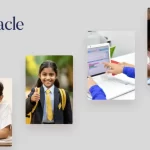There is no denying that the effective use of technology has given rise to various changes in how teachers and students interact with one another and the learning objectives throughout the education process. Children today pick up iPads before they pick up books or would rather play video games instead of playing with traditional toys. Hence, digital tools have become integral in how children interact and engage with the world around them.
However, some challenges need attention, as the doors to unlimited possibilities open up. For example, when a child reads something on the Internet, they might browse through it and end up reading irrelevant material. This brings forth a new set of questions that need to be analyzed: while it opens up many opportunities, what are parents or teachers supposed to do to utilize technology to aid in the learning process without hindering growth targets?
The answer lies in adhering to moderation and reasonability—after all, children are still progressing, technology is an enabler, and more focus is being placed on conventional engagement methods.
Navigating The Emerging World of Technology
There is a need to understand the meaning of digital literacy around children before a discussion about balance can occur. In short, when discussing digital literacy, this is about much more than simply time spent in front of a screen; instead, children are taught how to manipulate and explore technology geared more towards the roles of creativity and progression. It needs to improve capabilities such as the ability to engage with websites non-harmfully, the ability to differentiate between reliable sources of information and unreliable ones, and the beginner’s understanding of coding logic. This type of elementary set of skills provides one with the building blocks necessary for learning alongside ever-evolving markets in their soft aspects.
Striking a Balance Between Technology and Hands-On Learning
This poses a dilemma for parents and educators: how to integrate technology in a way that does not diminish hands-on learning but aids in its effectiveness. Here are some strategies that can help strike this balance:
Screen Time Restrictions
The Marion D. Hanks Foundation promotes the optimal approach toward the reasonable use of media or technology. This approach prohibits children between 2 and 5 from increasing their screen time to over an hour daily. This is encouraging because it fosters more educational engagement, especially when using apps or watching videos with more information.
Promote Active Engagement
Children should be accompanied by adults when interacting with technology. Workouts that include discussing the content, asking questions, or connecting digital content to real life can be truly effective. They make technology use more active and increase the possibility of taking advantage of important things.
Mix Practical and Theoretical Work
The practical side can be as easy as starting with an educational application about animals and moving on to making animal masks or pretending to be in a zoo. This makes the whole learning experience very engaging for children.
The Bigger Picture: Technology as a Tool, not a Substitute
In this era, technology has a lot of potential, but we need to remember that it should complement and not replace the existing methods of learning and play. Activities such as outdoor exploration, arts and crafts, and unstructured play significantly contribute to physical and cognitive development in a child. These activities allow the child to develop creativity, problem-solving and social skills, which can never be achieved through the screens.
But then, how can digital literacy help?
Digital literacy helps children understand how to live and behave safely in the digital world. While developing online relationships, etiquette and privacy issues can be taught to children in early childhood programs. At the same time, parents can reinforce these lessons by setting good examples of using digital technology and establishing “no technology” areas in the house. Parents and educators must actively find that balance where technology can enhance the chances of success rather than hinder the child’s development.
The digital revolution has ushered in changes in our lives, work and learning. It is not about eliminating screens but about how they are used to foster, teach, and motivate the new generation. Finding a balance, setting intentions, and working towards a common goal where technology and childhood coexist. The intersection of technology and real life can help us build a frame that considers the development of children more comprehensively and aligns with their growth in technology


